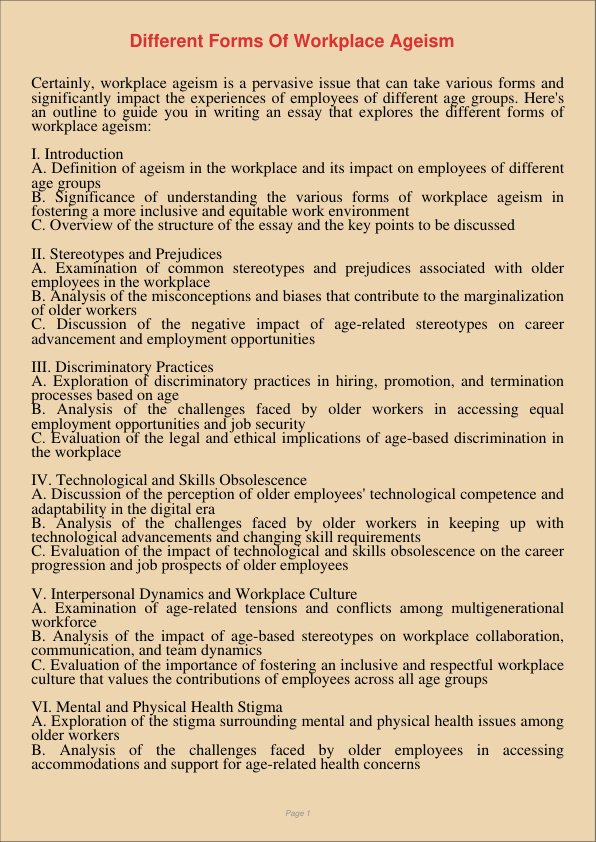Different Forms Of Workplace Ageism
Jan 7, 2024
workplace ageism
different forms
Psychology
Environmental Studies

Certainly, workplace ageism is a pervasive issue that can take various forms and significantly impact the experiences of employees of different age groups. Here’s an outline to guide you in writing an essay that explores the different forms of workplace ageism:
I. Introduction A. Definition of ageism in the workplace and its impact on employees of different age groups B. Significance of understanding the various forms of workplace ageism in fostering a more inclusive and equitable work environment C. Overview of the structure of the essay and the key points to be discussed
II. Stereotypes and Prejudices A. Examination of common stereotypes and prejudices associated with older employees in the workplace B. Analysis of the misconceptions and biases that contribute to the marginalization of older workers C. Discussion of the negative impact of age-related stereotypes on career advancement and employment opportunities
III. Discriminatory Practices A. Exploration of discriminatory practices in hiring, promotion, and termination processes based on age B. Analysis of the challenges faced by older workers in accessing equal employment opportunities and job security C. Evaluation of the legal and ethical implications of age-based discrimination in the workplace
IV. Technological and Skills Obsolescence A. Discussion of the perception of older employees’ technological competence and adaptability in the digital era B. Analysis of the challenges faced by older workers in keeping up with technological advancements and changing skill requirements C. Evaluation of the impact of technological and skills obsolescence on the career progression and job prospects of older employees
V. Interpersonal Dynamics and Workplace Culture A. Examination of age-related tensions and conflicts among multigenerational workforce B. Analysis of the impact of age-based stereotypes on workplace collaboration, communication, and team dynamics C. Evaluation of the importance of fostering an inclusive and respectful workplace culture that values the contributions of employees across all age groups
VI. Mental and Physical Health Stigma A. Exploration of the stigma surrounding mental and physical health issues among older workers B. Analysis of the challenges faced by older employees in accessing accommodations and support for age-related health concerns C. Evaluation of the implications of health-related ageism on employee well-being, productivity, and job satisfaction
VII. Strategies for Combating Workplace Ageism A. Discussion of organizational policies and practices aimed at promoting age-inclusive hiring and retention practices B. Analysis of the importance of promoting diversity and inclusivity in the workplace through training and education initiatives C. Evaluation of the role of leadership in fostering a culture of respect and appreciation for employees of all age groups
VIII. Conclusion A. Summary of the different forms of workplace ageism discussed in the essay B. Emphasis on the importance of addressing ageism to create a more inclusive and supportive work environment C. Call to action for implementing proactive measures to combat workplace ageism and promote a diverse and equitable workplace culture
Make sure to support your arguments with relevant case studies, statistical data, and credible sources to provide a comprehensive understanding of the impact of different forms of workplace ageism on employees and organizations.